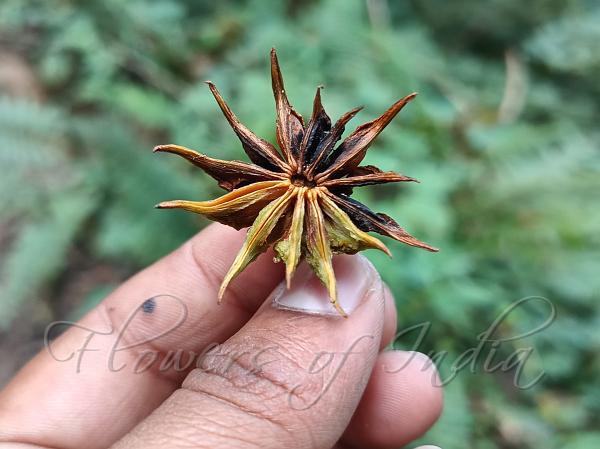|
| Himalayan Star Anise |
|

|

|
|
|
|
Photo: |
Botanical name: Illicium griffithii Family: Schisandraceae (Magnolia vine family)
Synonyms: Badianifera griffithii, Ternstroemia khasyana
Synonyms: Badianifera griffithii, Ternstroemia khasyana
Himalayan Star Anise is a tree up to 30 m tall. Leaves
are in clusters of 3-5 at distal nodes; leaf-stalk 0.7-1.7 cm; leaf
blade oblong-elliptic to narrowly obovate-elliptic, 7-13 x 2-5.5 cm,
leathery, midvein above prominently impressed, secondary veins 7-10 on
each side of midvein, below prominent, and above impressed to slightly
raised, base narrowly wedge-shaped, tip tapering. Flowers are borne in
leaf-axils or at branch-ends, carried on flower-cluster-stalk 1-2 cm
long. Tepals are 25 or 26, oblong-obovate (inner), 4-10 x 2.5-10 mm
(inner), papery to thinly leathery (outer) to fleshy (inner). Stamens
are about 30, 2.3-2.7 mm; filaments 1.1-1.4 mm; anthers 1-1.4 mm.
Fruiting stalk is 1.5-4.7 cm. Fruit is composed of 12 or 13 follicles;
follicles 1.4-2 x 0.8-1 x 0.3-0.5 cm. Seeds are about 7 x 5 x 2-2.5 mm.
Himalayan Star Anise is found in forests at altitudes of 1200-2300 m
in Bhutan, NE India, Cambodia, Malaya. Flowering: April-May.
Medicinal uses: The local communities in
Arunachal Pradesh have been using the plant for centuries to cure
abdominal pain, sinusitis, vomiting, cough, food poisoning, toothache
and dyspepsia. Apart from its use against ailments it is also used for
preparing sugar or butter salt tea, food preservative, as spice, and to
improve the strength of local alcohol.
The local communities in
Arunachal Pradesh have been using the plant for centuries to cure
abdominal pain, sinusitis, vomiting, cough, food poisoning, toothache
and dyspepsia. Apart from its use against ailments it is also used for
preparing sugar or butter salt tea, food preservative, as spice, and to
improve the strength of local alcohol.
Medicinal uses:
 The local communities in
Arunachal Pradesh have been using the plant for centuries to cure
abdominal pain, sinusitis, vomiting, cough, food poisoning, toothache
and dyspepsia. Apart from its use against ailments it is also used for
preparing sugar or butter salt tea, food preservative, as spice, and to
improve the strength of local alcohol.
The local communities in
Arunachal Pradesh have been using the plant for centuries to cure
abdominal pain, sinusitis, vomiting, cough, food poisoning, toothache
and dyspepsia. Apart from its use against ailments it is also used for
preparing sugar or butter salt tea, food preservative, as spice, and to
improve the strength of local alcohol. | Identification credit: Pakgam Ngulom, Niku Das | Photographed in West Kameng distt, Arunachal Pradesh. |
• Is this flower misidentified? If yes,